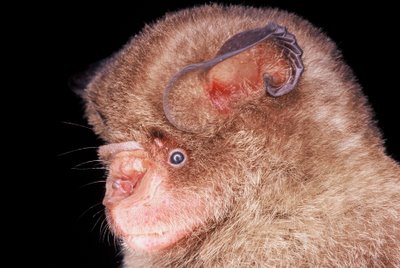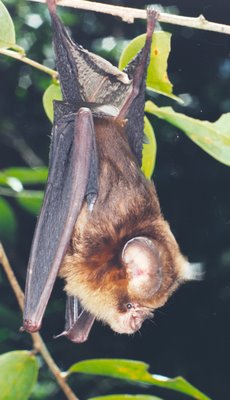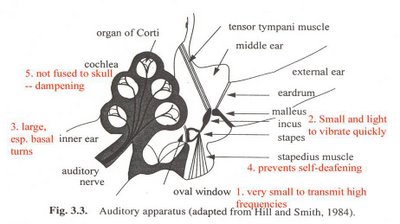Batastic
Bats. This posting will summarize what I learned about them in Malaysia. For those of you I have already talked to, I apologize for any redundancies.
First of all, to dispel a common myth, Bats are not blind. In fact, only the smaller insectivorous bats (microchiroptera) use the famous echolocation to navigate and hunt. Megachiroptera do not. The order Chiroptera that bats are classified under means “hand-wing” in Latin.
So we were only studying the microchiroptera suborder. We caught them using something called a harptrap that looks just like a harp. It is made by connecting horizontal metal bars with vertical and taught strands of fishing line spaced apart about 2 inches. The bats crashes into the trap, gets tangled and slides down into the bag below. They can’t walk or even crawl, and don’t have enough space to fly out, so they stay there, and are never hurt at all by the process (except sometimes these giant ants would invade the traps and kill them).
After we caught the bats we would “process” them ,which could be as little as reading the band of a recapture, and as much as weighing, banding, measuring bone-lengths and taking tissues samples of new bats. Some bats were very tame and could be easily held and petted, and others would bite themselves if they couldn’t bite you. Hipposideros Cervinus, the bat that we caught the most of was especially feisty. Here some pictures below.


Okay, so back to bat-facts. Most insectivorous bats eat half their body weight in a night of hunting. This is a lot more than most mammals. Considering that many weigh only about 3-14 grams that may not sound like much. Then consider that some bat caves in Texas have an estimated 10 million bats, with each one eating half of its body weight in insects each day. That’s quite an efficient pesticide! It’s free, too. Unfortunately, chemical pesticides are still used, and since bats eat so many of the poisoned bugs, bioamplification is killing them too. Less bats means more pesticides are needed to kill the extra bugs, and the circle becomes a spiral with and unhappy conclusion for bats. This begins to answer the question of what the purpose of a bat-conservation project could be anyway. Bats are also important for pollinating a lot of fruit trees in the old world.
It turns out that bats were the original hosts of the SARS virus too. They didn’t give it humans directly though, or the outbreak would have been a long time ago (as the variations in the virus in bats suggests that they have had it for awhile). No, it was our own fault, as we facilitated the transfer from bat to civet (a cat sized mammal) in the markets of china. These animals don’t interact at all in the wild, but they are both delicacies in parts of China, so they were unnaturally forced into close proximity of each other and humans. Host-hoping to the civet made the virus that gave us SARS. Bats couldn’t give it to us before.
Bats are in fact one of the oldest mammals. They are second in diversity only to rodents, having 1115+ different species! They are the only flying mammals too. It is remarkable how much they evolved so long ago.
Their most famous adaptation is of course how they use sonar to echolate for both navigation and hunting (though in general more for the latter). Like most animal attributes, this has carefully evolved to suit the needs of different bats in different environments. For instance, bats that hunt out in big open space have fewer obstacles to avoid, but also lesser density of prey. Thus they use a low frequency call that attenuates less when it travels far. They also use a long call because then it is easier to notice a subtle change in its broad range.
The bats we studied in the rainforest, on the other hand, have the opposite situation: lots of prey and lots of obstacles. Thus they use short-duration and high frequency calls to a get very detailed reading (it is tempting to say “picture” instead of “reading” here, but it is not fair to assume that they really see it the same way we do when we use radar and sonar imaging) of their surroundings. So precise in fact that they can identify a type of insect by how fast it flutters its wings or how soft its skin is (which is important, because some bugs taste better or are easier to eat than others). They do this by sending out and receiving calls at an amazingly fast rate. Amazing because their calls are so loud (at 120 Decibels!) that they would deafen themselves as they called if they did not lift the cochlea from their ear drum simultaneously. But then they have to pull the ear back together to hear the call on the way back. They can flex the muscle that controls this action about 300 times a minute, which means that they can make just as many calls. This is the fasting-moving muscle in any mammal. The diagram below shows more.

Much more can be said about echolocation (and flight, which I apologize for not talking about, but otherwise this posting would be ridiculously long), and I plan to teach about it to a much great depth in my Precalculus class this year (if interested, ask me and I’ll send you that information when it becomes available).
So remember, bats are important! The vampire bats are only in south America, and very few people each year are hurt by them. The professor that lead our group, Tigga Kingston, starts a professorship at Texas Tech this Fall and can be easily tracked down there if you want to learn more.

